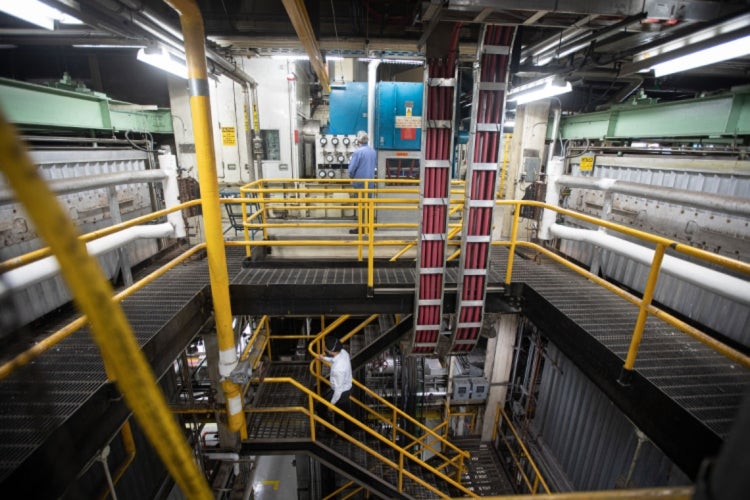U of T to cut carbon emissions in half on St. George campus by 2027
Project Leap, a public-private project, is believed to be the largest sustainability effort in the higher education sector

(photo by David Lee)
Published: February 2, 2024
The University of Toronto is accelerating efforts to decarbonize its St. George campus through a massive, $138-million infrastructure project that will cut emissions in half within three years.
Project Leap will begin phasing out natural gas in favour of electricity in the campus’s central steam plant and carry out deep energy retrofits to some of the most energy-intensive buildings.
Kickstarted with more than $50 million in Canada Infrastructure Bank (CIB) financing, the public-private sustainability project is among the largest in the higher-education sector. It will speed up the university’s efforts to make the St. George campus climate-positive, reducing more greenhouse gases than it emits, ahead of an original 2050 goal.
Ron Saporta, U of T’s chief operating officer, property services and sustainability, said the university is moving rapidly in response to the United Nations Intergovernmental Panel on Climate Change (IPCC)’s call to halve global emissions by the end of the decade.
“With 2030 just around the corner, we need to act immediately and decisively to tackle climate change,” Saporta said.
“This timeline wouldn’t have been possible without the support of the Canada Infrastructure Bank. We are grateful to them for acknowledging U of T’s commitment to helping forge a more sustainable future for Canada.”
He added that Project Leap’s ambitious scope is also driven by a recognition that U of T is the third-largest emitter of greenhouse gases in the broader public sector in Ontario, with the St. George campus accounting for more than 80 per cent of the university’s operational carbon footprint. Put simply, he said, it takes a lot of energy to run a research-intensive campus that serves roughly 100,000 students, faculty and staff a day – let alone one with a large collection of heritage buildings in a challenging climate characterized by cold winters and hot, humid summers.
https://www.utoronto.ca/media/oembed?url=https%3A//youtu.be/bdaPLpwHjwk%3Fsi%3Dq3TSTV7RPUvrbcIe&max_width=0&max_height=0&hash=bwGe6pplstlk_9mK4vIlt4LY3QINs8GwE7ND71283ZM
“Upgrading aging infrastructure at the University of Toronto’s St. George campus will ensure future performance and accelerate a low-carbon campus,” said Ehren Cory, CEO of the CIB. “Through the CIB’s Building Retrofits Initiative, our partnership with U of T will enable emission reduction efforts towards becoming climate-positive for students now and into the future.”
A significant portion of the St. George campus’s emissions come from the central steam plant, where gas-fired boilers produce steam that is used to heat most buildings on campus – as well as some off-campus properties including the Royal Ontario Museum. As part of Project Leap, one of the plant’s primary boilers will be converted from gas to electric.
Elsewhere, active heat recovery technologies will be used to reduce energy consumption by 40 per cent in the university’s most energy-intensive buildings – mainly by capturing and re-using heat that is normally lost to the surrounding environment as exhaust. Thirty-five buildings will also have their lighting upgraded to energy-efficient LEDs.

Several buildings will also be connected with the newly built geoexchange system beneath Front Campus, which is set to begin operations this spring. The system uses underground boreholes to store excess heat generated in the summer (thereby helping to cool spaces) for use in the colder months, utilizing heat pump technology with deep roots at the university.
Taken together, the measures will make it possible to reduce the campus’s greenhouse gas emissions, calculated at 91,000 tonnes last year, by more than 50 per cent by the end of 2027 – the year of U of T’s bicentennial.
“As the university approaches its 200th birthday, we want to make sure our energy systems are ready to meet the demands of the next 200 years, and we’re committed to doing so in an environmentally responsible manner,” Saporta said.
With the CIB’s financing contingent on the participation of a private lender, Project Leap establishes a novel framework for large-scale sustainability projects that could serve as a model for other institutions. The project received grants from Environment and Climate Change Canada (ECCC) and Ontario’s Independent Electricity System Operator (IESO), as well as financing from the Royal Bank of Canada, which was selected from a field of 11 bidders following a public procurement process.
“The University of Toronto is stepping up with their Climate Positive Campus plan, which is aligned with Canada’s 2030 Emissions Reduction Plan,” said Steven Guilbeault, minister of environment and climate change. “They’re leading the pack in global sustainability and making smart decarbonization investments. The Government of Canada will continue to support the University of Toronto in pursuing and achieving their ambitious targets.”
“Through Save on Energy, the IESO offers programs and incentives to help individuals, businesses and institutions to use energy more wisely,” said Tam Wagner, director, demand side management at the IESO. “The Industrial Energy Efficiency Program, which Project Leap was a successful applicant, supports investments in efficient electrification. This, in turn, makes lasting contributions that reduce long-term energy costs.”
The lower-cost financing achieved through the innovative model, Saporta said, amounts to more than $40 million in savings, allowing the university to complete retrofits – much earlier than would have otherwise been possible – of the Dentistry Building, Rehabilitation Sciences Building, Health Sciences Building, Old Administration Building and the Exam Centre.
U of T, which recently placed first in the 2024 QS Sustainability Rankings, is working with the Toronto Region Board of Trade to create a playbook that will help organizations in Toronto and elsewhere in Ontario to pursue and fund similar strategies to reduce carbon emissions.
The university previously collaborated with Universities Canada to host an event that presented Project Leap to university presidents from across the country.
Saporta’s team is also organizing workshops with counterparts at the University of California, Berkeley to exchange knowledge and best practices.
“What U of T has done with Project Leap is take lessons learned from other sectors and implement them into the higher education context – a campus that delivers research and education,” Saporta said. “This allows us to, quite literally, take a leap forward in realizing our climate-positive plans.
“It also creates a playbook that we hope others can draw on, so that we can together spur transformative sustainable infrastructure renewal beyond U of T.”
